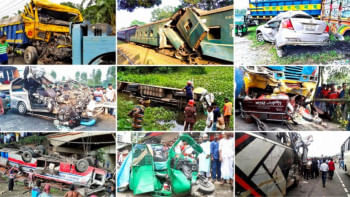Roads are becoming ever more treacherous

It was only the other day that we got an alarming review from a passenger welfare association saying it had recorded the highest number of Eid-time road casulties in its history during the fortnight around the Eid-ul-Azha holidays this year. Between July 3 and July 17, at least 398 people were killed and almost twice that number injured in the country. Now, thanks to another organisation, we have the full record of the month, and it turns out that the increase has been pretty steady all along. As many as 739 people, including 109 children, were killed and 2,042 others injured in July alone. This is, by any measure, a shocking number.
Bangladesh is clearly moving backwards in terms of road safety. Not a day goes by that we have news of some kind of tragedies – a deadly crash here, a treacherous level crossing there, someone being robbed, raped or drugged inside a bus, someone being thrown off it. Road crash, from which even pedestrians are not safe, certainly takes the cake. Of the 739 victims who died in July, 118 were padestrians, while 251 died in motorbike accidents, accounting for 34 percent of all deaths. Among other vehicles involved in crashes were three-wheelers, trucks, buses, pick-ups, covered vans, etc. No vehicle was spared, just as no district, one can presume, was left unscarred.
Overall, compared to the June figures, road crashes increased by 30.97 percent and fatalities increased by 36.48 percent in July. The Road Safety Foundation, which compiled the data, cited 10 major reasons for road accidents and also made 10 recommendations, none of which should sound unfamiliar given how frequently, and futilely, those were repeated. The total chaos in the transport sector – due in no small part to the impunity enjoyed by the owners/workers associations and the lack of action by concerned state agencies – means that Bangladesh had not only failed to reach its goal of reducing accidents by 50 percent by 2020, but is likely to miss its 2030 target as well.
The responsibility to turn this situation around falls primarily on the ministry of road transport and bridges, and agencies that it commands, who must answer for their consistent failure.
The difference between the goals set by the government for road safety and the reality on the ground couldn't be starker. Of course, the responsibility to turn this situation around falls primarily on the ministry of road transport and bridges, and agencies that it commands, who must answer for their consistent failure. Given the situation, the authorities should urgently implement the road safety act, which has been stuck in limbo since 2018. As experts have suggested, there should also be a Road Safety Fund to be spent on awareness, research, etc. Drivers need to be better trained and compensated. Rules related to fitness of vehicles, driving and traffic should also be strictly enforced. Without undertaking these measures, the pile of bodies on our roads will continue to mount.


 For all latest news, follow The Daily Star's Google News channel.
For all latest news, follow The Daily Star's Google News channel. 






Comments